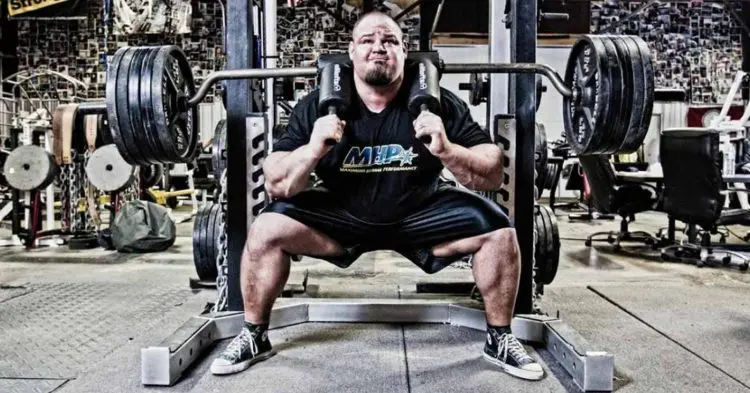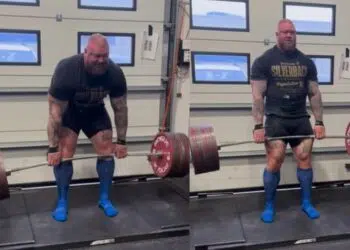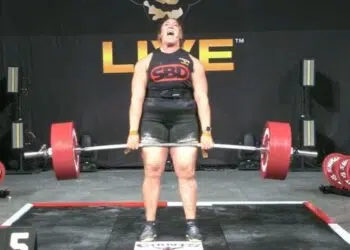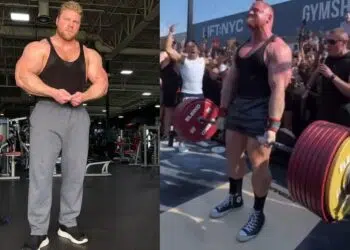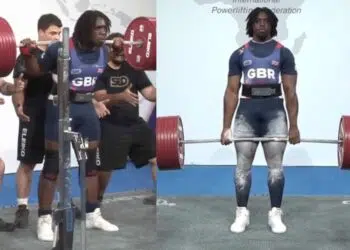If you’ve been lifting weights for a while, you probably know that barbells come in a variety of shapes and sizes. You may have picked up a barbell and noticed that it feels or behaves differently from others you’ve used in the past. You might even have a favorite barbell in your gym.
Of course, there are things called specialist barbells that look very different from standard straight bars, like football bars, safety squat bars, trap bars, cambered bars, thick bars, and so on. But that’s not what we’re talking about here.
Instead, we mean regular-looking barbells that have subtle differences which affect how they function.
Two main barbell variations worth knowing are deadlift bars and stiff bars. To the untrained eye, these bars look identical. Still, the differences in design may mean that one is better for your training than the other.
In this article, we reveal how these bars differ and the benefits of using one or the other for your workouts.
Level Up Your Fitness: Join our 💪 strong community in Fitness Volt Newsletter. Get daily inspiration, expert-backed workouts, nutrition tips, the latest in strength sports, and the support you need to reach your goals. Subscribe for free!
Deadlift Bar 101
Guess what; the deadlift bar is so-called because it was designed for deadlifting! It’s used mainly by powerlifters training or competing in the conventional and sumo deadlift.
Deadlift bars are typically a little longer than standard Olympic barbells and slightly thinner too. They also tend to have more bend or whip. Most deadlift bars have very deep knurling for a better grip and no central knurling.
The dimensions of a typical deadlift bar are:
- Length – 90.5 inches
- Thickness – 27 millimeters (1.063 inches)
- Sleeve length – 15.5 inches
- Distance between sleeves – 56 inches
- Weight – 44 lbs.
- Tensile strength – 190,000 psi
What does all this mean?
In simple terms, a deadlift bar is longer and flexes more, so it bends before the weights actually leave the floor. This means your deadlift starts a little higher, giving you a slight mechanical advantage. The heavier the weight, the more the bar flexes, and the higher you’ll be before you actually start pulling the weight off the floor.
Then, as the weights start to move, the bar flexes again, which provides a small amount of extra momentum, which may help you lift the bar faster.
The thinner diameter and extra knurling mean you’ll find it easier to grip a deadlift bar, and, as straps aren’t allowed in powerlifting competitions, this should help you lift heavier weights.
Plus, with no knurling in the middle of the bar, it’s less likely to drag on your legs as you pull the bar up. Less drag means less unnecessary resistance to overcome, and a lower chance of scraped shins.
While deadlifting with a deadlift bar won’t automatically add 50 lbs. to your deadlift, even a few extra pounds could be the difference between winning or losing a powerlifting competition. Users report that they can usually lift 3-5% more weight with a deadlift bar than a straight bar.
Stiff Bar 101
Stiff bars are standard Olympic bars. They’re what you’ll find in most gyms and can be used for a wide range of exercises, including squats, bench presses, overhead presses, bent-over rows, lunges, etc. They’re best thought of as multi-use barbells.
As their name implies, they’re stiffer than deadlift bars and are also called power bars. You can definitely deadlift with a stiff bar, and many lifters won’t even notice the difference between a deadlift bar and a stiff bar. That’s especially true if you are lifting light to moderate weights.
The dimensions of a typical stiff bar are:
- Length – 86.5 inches
- Thickness – 29 millimeters (1.14 inches)
- Sleeve length – 16-17 inches
- Distance between sleeves – 51.5 inches
- Weight – 20.4 kg (45 lbs.)
- Tensile strength – 205,000 psi
Stiff bars don’t tend to be as heavily knurled as deadlift bars as deep knurling would rip up your hands during cleans, curls, presses, etc. Also, they often have central knurling, so they are less likely to slip off your back during squats. The longer distance between sleeves means there is more space to adopt a wider grip, such as for snatches or wide-grip bench presses.
As you’d expect, a stiff bar doesn’t bend as much as a deadlift bar. With less flex, stiff bars don’t whip, so you’ll be lifting more of a “dead weight.”
Deadlift Bar vs. Stiff Bar – Pros and Cons
Depending on where you train, you may not have much choice about what type of barbell you use. But, if you belong to a gym with deadlift and stiff bars available or are thinking of buying your own bar for your garage gym, it’s worth considering these pros and cons before making your decision.

Deadlift bar pros:
- The flex in the bar means your deadlift starts from slightly higher off the floor
- A smaller diameter makes it easier to grip
- Deeper knurling means less chance of slipping
- No central knurling means fewer bloody shins
- The flex and whip of the bar could help you lift heavier weights
Deadlift bar cons:
- Less useful for squats, bench presses, and Olympic lifting
- Can be expensive
- Putting a deadlift bar in a squat rack could damage it
Stiff bar pros:
- Less flex is better for squats, bench presses, and Olympic lifting
- More forgiving knurling – not so tough on your hands
- Central knurling is helpful during squats
- Usually cheaper than deadlift bars
Stiff bar cons:
- Makes deadlifting a little harder
- More challenging to grip is you have small hands
Summary
Stiff bar: A stiff bar/power bar can be used for any lift! It is deigned to have no flex in the bar. Because of this, it is thicker than a deadlift bar (bar thickness 29mm).
The USAPL/IPF uses these bars for the squat, bench and deadlift, Since it is used for many lifts such as squatting, it has a center knurling.
Deadlift bar: A deadlift bar is made specifically for the deadlift and is made to flex and create whip. Because it is deigned to FLEX they are longer and thinner bars than stiff/power bars (bar thickness 27mm).
The flex in the bar creates a higher starting position for the lifter and the whip this bending creates when done right can help the lifter finish the lift. This bar is used in the USPA, RPS, SPF and many other powerlifting federations for the deadlift only! Deadlift bars also never have a center knurling as it is not necessary for deadlifting.
Deadlift Bar vs. Stiff Bar: Which Should You Use
As interesting as it is to compare deadlift bars and stiff bars, what really matters is what you’re going to use the bar for.
If you are a powerlifter who competes using a deadlift bar, it makes sense to use one in training if you can. After all, you should always train how you compete. Using a deadlift bar takes a little getting used to, and training with one means you’ll be able to lift heavier weights on the competition platform.
But, even if you are a competitive powerlifter, make sure your chosen federation uses deadlift bars, as not all do. Training with a deadlift bar and then competing with a stiff bar could be different enough to hurt your performance, as you’ll have trained yourself to use the bar’s flex and whip.
That said, if you have a deadlift bar, you still need a stiff bar for bench presses and squats, as deadlift bars are not really suitable for those exercises.
However, if you deadlift but aren’t a powerlifter and want one bar that “does it all,” a stiff bar or power bar is your best option. Armed with a power bar, you won’t have to waste money or space on a bar just for deadlifts, and you probably won’t miss the deadlifting advantages that a specialist deadlift bar provides.
Deadlift Bar vs. Stiff Bar – Wrapping Up
A deadlift bar is a specialized piece of equipment designed primarily for powerlifters. So, if you deadlift competitively, you will probably enjoy the benefits a deadlift bar can offer.
But the average lifter doesn’t really need a dedicated deadlift bar and may not even notice the difference between a stiff bar and one that flexes more. Plus, if you buy a deadlift bar, you’re going to need a stiff bar anyway, as deadlift bars aren’t designed for squats, bench presses, etc.
Ultimately, any type of barbell can help you get bigger and stronger, so use the one that best suits your training needs and goals.

